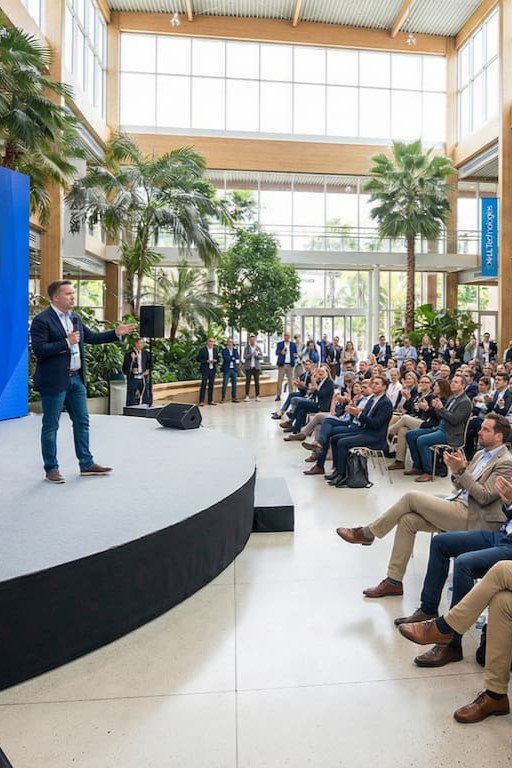Dan Charles
18/09/2025
Table of Contents

Key Takeaways
- SEO tools miss emerging trends because they only show past search behavior, not future market requirements. The biggest opportunities exist in “zero search volume” topics that represent genuine market shifts.
- Strategic content timing creates competitive moats. Businesses that identify and act on emerging trends 2-3 years early capture blue ocean positioning before markets become competitive.
- Multi-layered intelligence systems outperform keyword research alone. Combine client conversations, cross-industry analysis, regulatory signals, and data synthesis to identify genuine opportunities.
- Sustainability demonstrates the pattern perfectly. What seemed like wasted effort in 2022 now drives thousands of monthly visits from ideal clients, proving the value of compass-over-map thinking.
- Future positioning beats current optimization. The smartest event businesses invest content resources where the market is heading, not where it stands today.
The SEO Tool Said Nobody Was Searching. We Created the Content Anyway.
Three years ago, I made what seemed like a terrible business decision. My team at Codarity was working with an event client who wanted to focus heavily on sustainability content. We pulled up the SEO tools, typed in variations of “event sustainability,” “sustainable events,” and “green event planning.” The response was brutal: zero search volume across the board.
According to every keyword research tool available, nobody was searching for this content. The data was clear, or so it seemed.
Fast forward to today: those “zero search volume” articles are generating thousands of monthly visits from ideal clients. Not random researchers or curious browsers, but qualified prospects actively looking for event agencies who understand sustainability requirements.
Here’s what I learned about the difference between where your market is now and where it’s heading, and why the smartest event businesses are making content bets that look crazy until they don’t.
The Compass vs. Map Principle
There’s a fundamental difference between looking at where you are on the map right now versus following where the compass is pointing. Most event businesses make content decisions based on current search data, what people are actively typing into Google today.
But the market doesn’t stand still. While you’re optimizing for today’s searches, the requirements that will drive tomorrow’s business decisions are already forming.
In 2022, when we started creating sustainability content, the average global event sustainability score was around 16.95 out of 30. Today, that number has jumped to 19.07, reflecting industry-wide improvements. More importantly, attendee expectations have shifted dramatically. Sustainability credentials are now one of the top three selection criteria for event attendance.
The businesses that recognized this shift early didn’t wait for the search volume to appear in SEO tools. They started building their authority when it was still a “blue ocean” opportunity.
Why SEO Tools Miss Emerging Trends
Traditional keyword research tools have a fatal flaw: they can only tell you what people searched for yesterday, not what they’ll need tomorrow. They’re rearview mirrors, not windshields.
Here’s what actually happens with emerging business requirements:
Stage 1: Industry Whispers – Requirements start as conversations in boardrooms, industry events, and client meetings. No one’s Googling yet because they’re not even sure what to call it.
Stage 2: Early Adopter Movement – Forward-thinking businesses start experimenting and sharing results. Search volume remains minimal because the language is still evolving.
Stage 3: Market Validation – Success stories emerge, case studies get published, and mainstream businesses start paying attention. SEO tools begin detecting patterns.
Stage 4: Competitive Red Ocean – Everyone rushes to create content, driving up competition and cost while reducing opportunity.
Most businesses wait until Stage 3 or 4 to act. By then, the early positioning advantage is gone.
The Real Intelligence Behind Trend Identification
Smart content strategy isn’t about guessing trends—it’s about developing multiple intelligence streams that help you identify genuine market shifts before they become obvious.
At Codarity, we’ve built what I call a “multi-layered intelligence system”:
Client Conversation Intelligence: Regular deep conversations with clients about market shifts, client requirements, and project evolution. Not just campaign performance metrics, but actual market intelligence.
Cross-Market Analysis: Tracking trends across industries that eventually influence events. Sustainability didn’t start in events, it began in consumer goods, moved through corporate procurement, and then hit our industry.
Data Synthesis: Using modern tools to crunch significantly more data across wider markets, then cross-referencing against specific client ICPs and marketing attribution data.
This approach helped us identify sustainability as a strategic content opportunity years before search volume validated the decision.
The Sustainability Case Study: From Zero to Strategic Advantage
When we started creating sustainability content for event clients, every metric suggested we were wasting time:
- Zero search volume on keyword research tools
- Minimal industry discussion online
- Few competitors addressing the topic
But our intelligence system was telling a different story:
- Corporate clients were increasingly asking about environmental impact
- Regulatory pressure was building across Europe
- Attendee expectations were shifting toward responsible events
Today, the data validates our early positioning:
- Travel emissions remain the industry’s largest footprint driver
- Supply chain transparency adoption is still under 25%, a massive opportunity
- European events outperform North American ones in sustainability metrics
- Stricter reporting standards are accelerating industry adoption
The clients who built sustainability authority early now enjoy significant competitive advantages. They’re capturing prospects who specifically search for agencies with environmental expertise.
Building Your Own Market Intelligence System
You don’t need a complex agency operation to identify emerging opportunities. Here’s how event businesses can develop better market intelligence:
1. Upgrade Client Conversations Stop limiting discussions to project details and campaign performance. Ask about:
- Changes in client procurement requirements
- New compliance or reporting demands
- Shifts in stakeholder expectations
- Industry conversations at their conferences
2. Follow the Money Trail Track where corporate spending priorities are shifting. Sustainability requirements often appear in procurement documents before they show up in search data.
3. Monitor Adjacent Industries Event requirements often follow patterns from other sectors. Corporate sustainability reporting requirements preceded event sustainability demands by 3-5 years.
4. Watch for Regulatory Signals The EU’s Corporate Sustainability Reporting Directive didn’t surprise anyone paying attention. Similar patterns exist for emerging requirements.
The Strategic Content Advantage
Creating content in emerging areas before search volume appears offers several advantages:
Authority Positioning: You become the go-to resource when the market awakens to the topic.
SEO Foundation: Your early content builds domain authority in the space, making it easier to rank when competition increases.
Sales Enablement: Your content becomes proof of forward-thinking expertise during client conversations.
Competitive Moat: Established content creates barriers for later entrants to the space.
The businesses thriving in sustainable events today aren’t just benefiting from market timing—they’re reaping the rewards of strategic content investments made when the opportunity wasn’t obvious.
The Risk-Reward Calculation
Not every “zero search volume” topic will become the next sustainability. The key is developing judgment about which emerging requirements represent genuine market shifts versus temporary industry buzz.
Look for convergence signals:
- Regulatory pressure building
- Cross-industry adoption patterns
- Client requirement evolution
- Technology enabling new possibilities
- Social or environmental pressure creating demand
Most importantly, consider the downside risk. Creating quality content about emerging topics rarely hurts—even if the trend doesn’t explode, you’ve demonstrated thought leadership and market awareness.
Your Competitive Moat Starts Now
The event industry is experiencing rapid transformation. AI personalization for corporate buyers, hybrid format optimization, wellness integration, and immersive technology applications are all following similar patterns to sustainability. Early whispers growing into market requirements.
The question isn’t whether these trends will impact your business. It’s whether you’ll build authority in emerging areas while they’re still blue ocean opportunities, or wait until they become competitive red oceans.
Smart event businesses understand that content strategy is about positioning for future opportunities, not just capturing current searches. They’re willing to invest in topics that show strategic potential even when SEO tools suggest nobody cares yet.
Three years from now, you’ll either be the event business that clients find when they search for emerging expertise, or you’ll be wondering how your competitors got such a head start.
The compass is pointing toward several emerging opportunities right now. The only question is: will you follow where it’s pointing, or wait until everyone else can see the destination?
Ready to identify emerging content opportunities for your event business? Understanding which trends represent genuine market shifts versus temporary buzz requires strategic analysis of multiple intelligence streams. The businesses that master this skill will build the competitive moats that define the next decade of industry leadership.
Want to position your event business ahead of emerging market trends? Book an Evergreen Event Profit System (EEPS) Strategy Call to discover how strategic content positioning can transform your lead generation and competitive advantage.

The Real AI Revolution in Events Isn’t What Cvent’s Selling

Why Your Event Business Doesn’t Need More Martech: It Needs a Coherent Message

Universal Attribution for Event Businesses: Track Every Lead Across Any Form Tool




